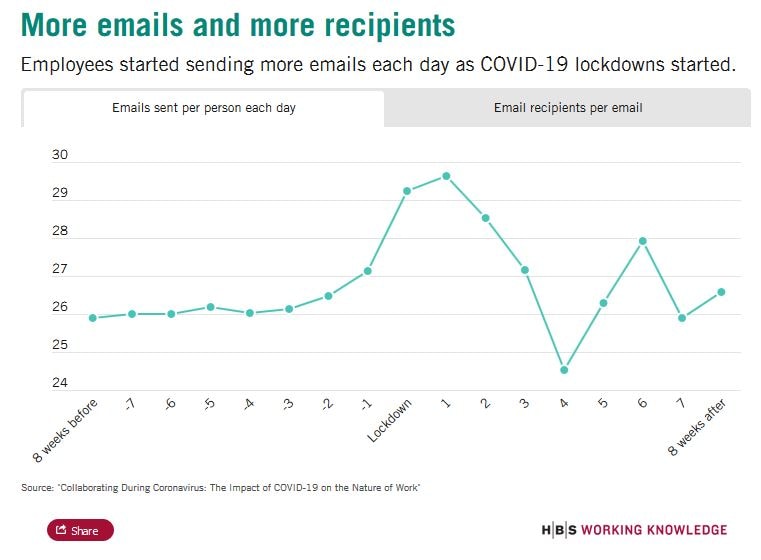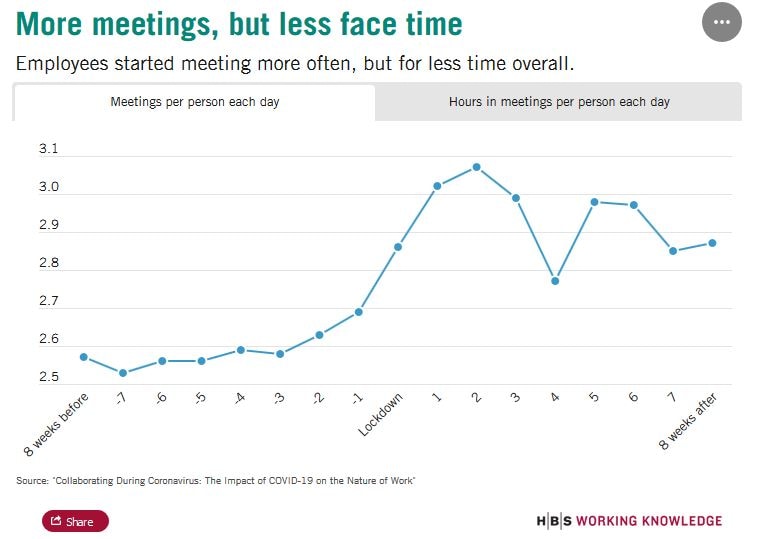
You're right! You are working longer and attending more meetings
A study of 3 million people confirms what many work-from-home employees already know: We're swamped. Research by Raffaella Sadun, Jeffrey Polzer, and colleagues
 Image: Shutterstock
Image: ShutterstockWork-from-home employees whose days seem longer, with more meetings and emails than ever before, may find a new Harvard Business School study validating.
An analysis of the emails and meetings of 3.1 million people in 16 global cities found that the average workday increased by 8.2 percent—or 48.5 minutes—during the pandemic’s early weeks. Employees also participated in more meetings, though for less time than they did before COVID-19 sent many workers home.
“There is a general sense that we never stop being in front of Zoom or interacting,” says Raffaella Sadun, professor of business administration in the HBS Strategy Unit. “It’s very taxing, to be honest.”
Shifting to remote work at the start of the pandemic stripped away whatever was left of the elusive 9-to-5 business day and replaced it with videoconferencing and “asynchronous work.” With at least 16 percent of Americans planning to keep working from home part of the time after COVID-19 abates, researchers are probing how virtual interaction might reshape organizations.
In the first large-scale analysis of digital communication early in the crisis, the team—Sadun; Jeffrey T. Polzer, the UPS Foundation Professor of Human Resource Management; HBS doctoral candidate Evan DeFilippis; New York University doctoral student Stephen Michael Impink; and former HBS research associate Madison Singell—studied aggregated, anonymous emails and meeting invitations of employees at 21,500 companies in North America, Europe, and the Middle East.
“The role of an office is to congregate and help people work together,” Sadun says. “For us, the question was, ‘What happens when you cannot have that physical space anymore?’ How do people adjust their work patterns?”
Longer days and more check-ins
The team compared the frequency and timing of emails sent within and outside organizations eight weeks before the start of pandemic-related lockdowns and eight weeks after. On average, they found that:
- Employees sent 5.2 percent more emails a day.
- Emails had 2.9 percent more recipients.
- About 8.3 percent more emails were sent after business hours.

Sadun and Polzer also analyzed meeting invitations—the quantity, duration, and number of attendees—and observed that:
People attended 13 percent more meetings.
Each meeting was 12 minutes—or 20 percent—shorter, reducing the number of meeting hours by 12 percent, or 19 minutes.
The number of people invited to each meeting rose by two, or 14 percent.

Perhaps most striking: As researchers compared the time when people started sending emails and attending meetings each day and when they ended, they saw that the average workday lasted 8.2 percent longer, an extra 48.5 minutes. While it’s unlikely that employees worked continuously during that period, Sadun suspects that employees adopted more fluid schedules to accommodate interruptions from, say, a child struggling with virtual learning or a sick family member.

“Unless you really are able to create distinct boundaries between your life and your work, it's almost inevitable that we see these blurring lines,” she says.
The research team detailed their findings in the working paper Collaborating During Coronavirus: The Impact of COVID-19 on the Nature of Work, released by the National Bureau of Economic Research in July.
Probing the productivity and morale toll
The anonymized nature of the data made it difficult to discern the quality of the meetings and email communication, and the impact on employees’ well-being. The study also didn’t include the time spent on collaboration tools, such as Slack and Microsoft Teams, which have become increasingly popular.
To tackle some of these questions, Sadun has been studying how 300 knowledge workers have been spending their time during the pandemic and how those activities affect their moods and perceived effectiveness. So far, the preliminary conclusions have been highly varied and personal.
“This is one of those things where it’s hard to make one statement for everybody,” Sadun says. “If you have a large house, life is good. If you have to combine your bedroom with your office, it’s not as good.”
It doesn’t take a detailed time log to know that videoconferencing fatigue has long set in for many employees, a likely factor in shrinking meeting times. Gathering in person doesn’t seem as draining as staring at a screen.
“The issue with Zoom is that you’re always on there. You have to show a concentrated face the whole time,” she says. “It's very unnatural to be constantly looking attentive for hours.”
How managers can be mindful
The pandemic workforce has created a significant challenge for managers, Sadun says. She offers three pieces of advice to leaders of remote workforces:
Empathize with workers’ unique circumstances. Managers need to know what their employees are juggling to provide the right professional support.
Focus on output, not hours. It’s virtually impossible to track how employees are actually using their time. Instead, managers should focus on the quality of their work.
Expect wide differences in productivity across employees, for now. While some people will find working from home energizing, many employees probably won’t be able to be as effective as they normally are.
Sadun, who spent the spring advising the Italian government about how to reopen its economy post-lockdown, hasn’t been immune to the pandemic’s disruption. But, for an academic analyzing a once-in-a-century pandemic and its economic fallout, working has been a way of coping.
“This is our way to make sense of the world,” Sadun says. “We try to make ourselves useful because we understand that there is something really big happening around us.”
Danielle Kost is senior editor of Harvard Business School Working Knowledge.
This article was provided with permission from Harvard Business School Working Knowledge.







